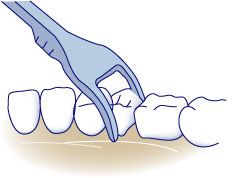Flossing
Did you know that flossing your teeth is important as brushing them? In fact, if you don't floss, you're missing as much as 40% of your teeth – leaving them untouched and unclean!
After you've brushed the fronts, backs and tops of your teeth, you need to get between them—to get to areas beyond the reach of your toothbrush. Interdental cleaning makes your teeth and gums feel clean because it reaches areas a toothbrush can't reach. It also keeps your breath fresh and, more importantly, it can stop gum disease in its tracks.
Here at Dentalcare West, our hygienist can show you good flossing techniques at your next hygienist appointment. Here are a few helpful tips:
How to floss

1 - Take about 18 inches of floss and loosely wrap most of it around each middle finger (wrapping more around one finger than the other) leaving an inch of floss in between.

2 - With your thumbs and index fingers holding the floss taut, gently slide it down between your teeth, while being careful not to snap it down on your gums.

3 - Curve the floss around each tooth in a "C" shape and gently move it up and down the sides of each tooth, including under the gumline. Unroll a new section of floss as you move from tooth to tooth.
My gums bleed when I floss. Should I stop when this happens?
Don't worry about your gums bleeding at first – this is quite common. It may be a sign that you have some form of gum disease. After a few days of flossing, the bleeding should stop, as your gums become healthier. If bleeding persists, consult your dentist.
How long does it take for flossing to start paying off?
Flossing provides unmistakable benefits that start from day one. After flossing, your teeth and gums feel cleaner because the floss reaches areas your toothbrush can't. Your breath will be fresher, and the health of your gums will improve.
What kind of floss is best?
While there are a number of different kinds of floss (waxed, unwaxed, and flavoured), they are all designed to reach between the teeth and below the gum line to remove plaque. So use whatever type of floss you prefer. Some of the newer waxed flosses are easier to use: they are more shred-resistant and slide smoothly between the teeth.
Dental flossettes
If you have trouble holding or using floss, you may want to try a dental flossette. Once the flossette is inserted between the teeth, use the same method of flossing as above. Ask your dentist or hygienist to show you if you are unsure.

If you have braces or restorative dental work (such as a bridge) that interferes with normal flossing, you may want to try Super floss. This floss has a stiffened end that allows it to be threaded in between your teeth or under bridgework.

My teeth have wide gaps between them: do I still have to floss?
Even if you have widely spaced teeth, plaque still forms between them and below the gum line - areas your brush can't reach.
When should my children start flossing?
Consult your dentist, but a good rule of thumb is when two teeth touch. This usually happens first with the back teeth. To begin with, you will have to floss their teeth for them, but they will eventually be able to do it for themselves. Remember, the earlier your children start flossing, the more likely it will become part of their daily routine.